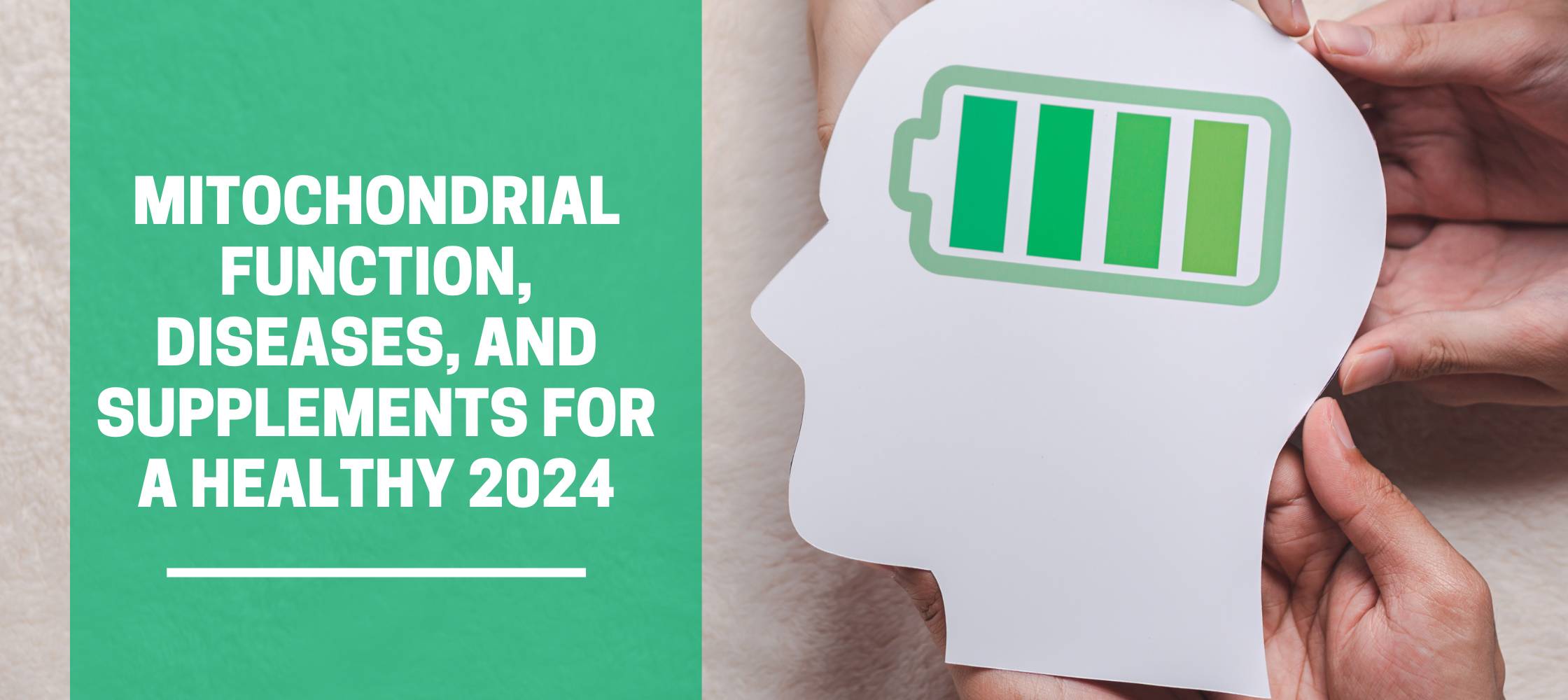Mitochondrial Function, Diseases, and Supplements for a healthy 2024
Mitochondria, the cellular powerhouses, are pivotal players in the symphony of cellular function. This guide meticulously explores the complex landscape of mitochondrial function, delves into the intricacies of mitochondrial diseases, and scrutinizes the potential of supplements in the unending quest for optimal health. Through this detailed examination, we aim to unravel the mysteries encapsulated within mitochondria, providing profound insights into cellular vitality and opening avenues for the comprehensive optimization of health.
Structure of Mitochondria
Amidst the intricate tapestry of cellular biology, mitochondria emerge as architectural marvels. Defined by outer and inner membranes, matrix, and cristae, these organelles intricately shape the cellular landscape. The outer membrane acts as a protective barrier, regulating substance passage, while the inner membrane, rich in folds called cristae, provides a vast surface for essential biochemical processes. Within this structure lies the matrix, a gel-like substance housing enzymes vital for the metabolism of carbohydrates and fats. A nuanced comprehension of these structural elements becomes paramount, forming the foundation for grasping the multifaceted functions that underpin cellular vitality and overall well-being. Exploring the intricacies of mitochondrial structure unveils the blueprint of cellular health, a foundation essential for understanding their profound impact on the intricate dance of life within each cell.
Mitochondrial Function
The functions of mitochondria extend far beyond their role as cellular power generators. Orchestrating a symphony of processes, these organelles influence metabolic regulation and apoptosis, marking their profound impact on cellular health. Beyond the traditional role of ATP production through oxidative phosphorylation, mitochondria actively participate in metabolic processes, influencing the breakdown of carbohydrates, fats, and amino acids. Additionally, they play a pivotal role in apoptosis, the programmed cell death essential for maintaining cellular integrity. This intricate interplay of functions underscores the significance of mitochondria in shaping the cellular landscape. By delving into the nuances of mitochondrial functions, we gain insights into their pivotal role in maintaining cellular health and contributing to the overall well-being of the organism.
Mitochondrial DNA
Mitochondrial DNA (mtDNA) presents a distinctive aspect of cellular genetics. Its circular structure and unique maternal inheritance contribute significantly to genetic diversity and hereditary disease transmission. Unlike nuclear DNA, mtDNA is exclusively inherited from the maternal line during fertilization. This distinct inheritance pattern offers insights into genetic diversity and the transmission of hereditary diseases across generations. Understanding the characteristics of mitochondrial DNA adds layers to our comprehension of cellular genetics, shedding light on its role in shaping individual traits and predispositions. Exploring the nuances of mtDNA unravels a genetic landscape intertwined with cellular health, providing valuable insights into the intricate interplay between genetics and the cellular tapestry.
Cellular Energy Production
Central to cellular energy production, mitochondria orchestrate two crucial processes: oxidative phosphorylation and the electron transport chain. These intricacies unfold within the inner mitochondrial membrane, serving as the powerhouse for generating adenosine triphosphate (ATP), the cellular energy currency. Oxidative phosphorylation involves the transfer of electrons through a series of protein complexes, culminating in ATP production. Simultaneously, the electron transport chain facilitates this process by creating a proton gradient across the inner membrane. The energy generated fuels cellular activities, highlighting the pivotal role of mitochondria in sustaining physiological functions. Understanding these intricate processes sheds light on the fundamental mechanisms that dictate cellular energy production, emphasizing the significance of mitochondria in maintaining cellular vitality and overall health.
Mitochondria and Health
The intricate relationship between mitochondrial function and overall health is a complex interplay that extends beyond the cellular realm. As cells age, mitochondrial function tends to decline, impacting energy production and contributing to various health issues. This age-associated decline is implicated in neurodegenerative disorders, cardiovascular diseases, and metabolic imbalances. The understanding of this connection unravels potential anti-aging strategies and therapeutic interventions aimed at preserving mitochondrial function. Mitochondria’s role in cellular health emerges as a key player in the broader context of aging and age-related diseases. By comprehending this relationship, researchers and clinicians gain insights into potential interventions to mitigate the impact of aging on cellular vitality and promote healthier aging.
Mitochondrial Dysfunction
Recognizing and comprehending mitochondrial dysfunction becomes paramount in addressing a spectrum of health challenges. Genetic mutations, environmental stressors, and the natural aging process can compromise mitochondrial health, leading to dysfunctional cellular activities. This dysfunction is implicated in various disorders, including neurodegenerative diseases like Alzheimer’s and Parkinson’s. Cellular processes dependent on energy production and regulation become disrupted, underscoring the critical role mitochondria play in maintaining cellular homeostasis. Investigating the causes and consequences of mitochondrial dysfunction is an active area of research, offering potential avenues for therapeutic interventions targeting these intricate cellular powerhouses. As we unravel the complexities of mitochondrial dysfunction, we pave the way for advancements in medical strategies to address not only mitochondrial disorders but also broader health challenges associated with compromised cellular vitality.
Mitochondria and Exercise
Regular exercise stands as a potent modulator of mitochondrial function, underscoring the dynamic nature of these cellular powerhouses. Physical activity induces adaptations within mitochondria, enhancing their efficiency in energy production. This adaptation is particularly evident in skeletal muscles, where mitochondria play a crucial role in meeting the increased energy demands during exercise. Exercise not only influences mitochondrial quantity but also enhances their quality, contributing to overall cellular health. The symbiotic relationship between mitochondria and exercise unfolds as a cornerstone in maintaining optimal cellular function through physical activity. Understanding this intricate interplay provides valuable insights into strategies for enhancing cellular vitality, promoting overall well-being, and harnessing the benefits of exercise to optimize mitochondrial health.
Mitochondrial Disease
Mitochondrial diseases encompass a spectrum of disorders arising from genetic mutations affecting mitochondrial function. Symptoms can manifest in various organs, leading to a wide range of clinical presentations. Diagnosis involves a multidisciplinary approach, combining clinical assessments, genetic testing, and imaging studies. However, the complexity of mitochondrial genetics poses challenges in pinpointing specific genetic abnormalities. Treatment approaches primarily aim to manage symptoms, given the absence of curative interventions. Ongoing research explores potential targeted therapies addressing the root causes of mitochondrial dysfunction. A multidisciplinary approach involving geneticists, neurologists, and other specialists is crucial for addressing the unique challenges posed by these complex disorders. Understanding mitochondrial diseases contributes to ongoing efforts in diagnostics, treatment strategies, and therapeutic advancements to improve the quality of life for individuals affected by these intricate and challenging conditions.
Mitochondrial Inheritance
Mitochondrial DNA (mtDNA) follows a distinctive maternal inheritance pattern, setting it apart from nuclear DNA. During fertilization, mitochondria in the sperm are typically excluded from the fertilized egg, resulting in offspring inheriting mitochondria exclusively from the mother. This maternal lineage inheritance pattern holds significant implications for understanding genetic diversity and hereditary diseases. Disorders arising from mitochondrial DNA mutations are inherited maternally, offering insights into the transmission of these conditions across generations. Studying mitochondrial inheritance patterns enhances our understanding of population genetics and the unique contribution of mitochondrial DNA to individual genetic makeup. This exploration into mitochondrial inheritance not only elucidates genetic transmission but also contributes to our understanding of the complex interplay between maternal genetics and the health outcomes of successive generations.
Mitochondrial Supplements
Mitochondrial supplements have garnered attention for their potential in supporting and enhancing mitochondrial function. These supplements aim to optimize cellular energy production, metabolic regulation, and overall cellular health. While nutritional strategies play a crucial role, specific supplements such as coenzyme Q10, L-carnitine, and alpha-lipoic acid target mitochondrial function. Coenzyme Q10, a vital antioxidant, supports energy production within mitochondria. L-carnitine facilitates the transport of fatty acids, contributing to energy production efficiency. Alpha-lipoic acid, with dual antioxidant properties, enhances cellular energy production and supports overall mitochondrial function. Understanding the significance of these supplements provides individuals with potential tools for supporting their mitochondrial health. However, it is crucial to approach supplementation cautiously and seek guidance from healthcare professionals to ensure appropriateness and effectiveness based on individual health needs.
Mitochondrial Disease Treatment
The treatment landscape for mitochondrial diseases is intricate, reflecting the diverse nature of these disorders. Current approaches primarily focus on managing symptoms, employing a multidisciplinary strategy involving neurologists, geneticists, and metabolic physicians. Symptomatic treatments aim to alleviate specific issues, such as respiratory problems or muscle weakness, thereby enhancing the quality of life for affected individuals. Ongoing research is dedicated to developing targeted therapies addressing the root causes of mitochondrial dysfunction. Challenges persist due to the genetic heterogeneity and complexity of mitochondrial disorders, highlighting the need for continued collaboration between researchers, clinicians, and patients to advance our understanding and treatment options. While current treatments primarily manage symptoms, the evolving landscape of research offers hope for future breakthroughs that may provide more targeted and effective therapeutic interventions for individuals grappling with mitochondrial diseases.
Conclusion
In conclusion, delving into the intricate world of mitochondria provides a profound appreciation for their role in cellular health. Understanding their structure, functions, and the implications of dysfunction offers valuable insights for both scientific exploration and personal health optimization. Whether through regular exercise, careful supplementation, or the innovative Advanced Mitochondrial Formula, individuals have the opportunity to positively influence their mitochondrial health and, consequently, their overall well-being.
Frequently Asked Questions
- Are mitochondrial supplements safe for everyone?
- While generally considered safe, it’s crucial to consult with healthcare professionals, especially if you have underlying health conditions or are on medications.
- How does mitochondrial dysfunction contribute to neurodegenerative diseases?
- Mitochondrial dysfunction can compromise energy production in neurons, contributing to the progression of diseases like Alzheimer’s and Parkinson’s.
- Can lifestyle factors impact mitochondrial health?
- Yes, factors such as regular exercise, a balanced diet, and adequate sleep play significant roles in supporting mitochondrial health.
- Is the Advanced Mitochondrial Formula suitable for vegetarians?
- The formula may contain ingredients derived from both plant and animal sources. It’s advisable to check the product details for specific information.
- How long does it take to see the effects of mitochondrial supplements?
- Individual responses vary, but consistent use over several weeks to months is often recommended for noticeable benefits.
References
- Wallace, D. C. (2005). A mitochondrial paradigm of metabolic and degenerative diseases, aging, and cancer: A dawn for evolutionary medicine. Annual Review of Genetics, 39, 359-407.
- This comprehensive review by Douglas C. Wallace explores the mitochondrial paradigm in various diseases, aging, and its implications for evolutionary medicine.
- Picard, M., & Turnbull, D. M. (2013). Linking the metabolic state and mitochondrial DNA in chronic disease, health, and aging. Diabetes, 62(3), 672-678.
- Picard and Turnbull delve into the intricate link between metabolic state, mitochondrial DNA, and their role in chronic diseases, health, and aging.
- López-Otín, C., Blasco, M. A., Partridge, L., Serrano, M., & Kroemer, G. (2013). The hallmarks of aging. Cell, 153(6), 1194-1217.
- In this seminal paper, López-Otín et al. discuss the hallmarks of aging, including mitochondrial dysfunction, providing a foundational understanding of aging processes.
- Nunnari, J., & Suomalainen, A. (2012). Mitochondria: in sickness and in health. Cell, 148(6), 1145-1159.
- This Cell review by Nunnari and Suomalainen provides an overview of the multifaceted roles of mitochondria in health and disease.
- Ylikallio, E., & Suomalainen, A. (2012). Mechanisms of mitochondrial diseases. Annals of Medicine, 44(1), 41-59.
- Ylikallio and Suomalainen comprehensively review the mechanisms underlying mitochondrial diseases, offering insights into their diverse etiology and potential therapeutic targets.
Related Articles
Low Energy? Then Take Mitochondrial Supplements
Mitochondrial Supplements: Maximizing Your Energy Potential
Understanding Mitochondrial Function: A Comprehensive Guide
Review of the Best Mitochondrial Supplement of 2024





